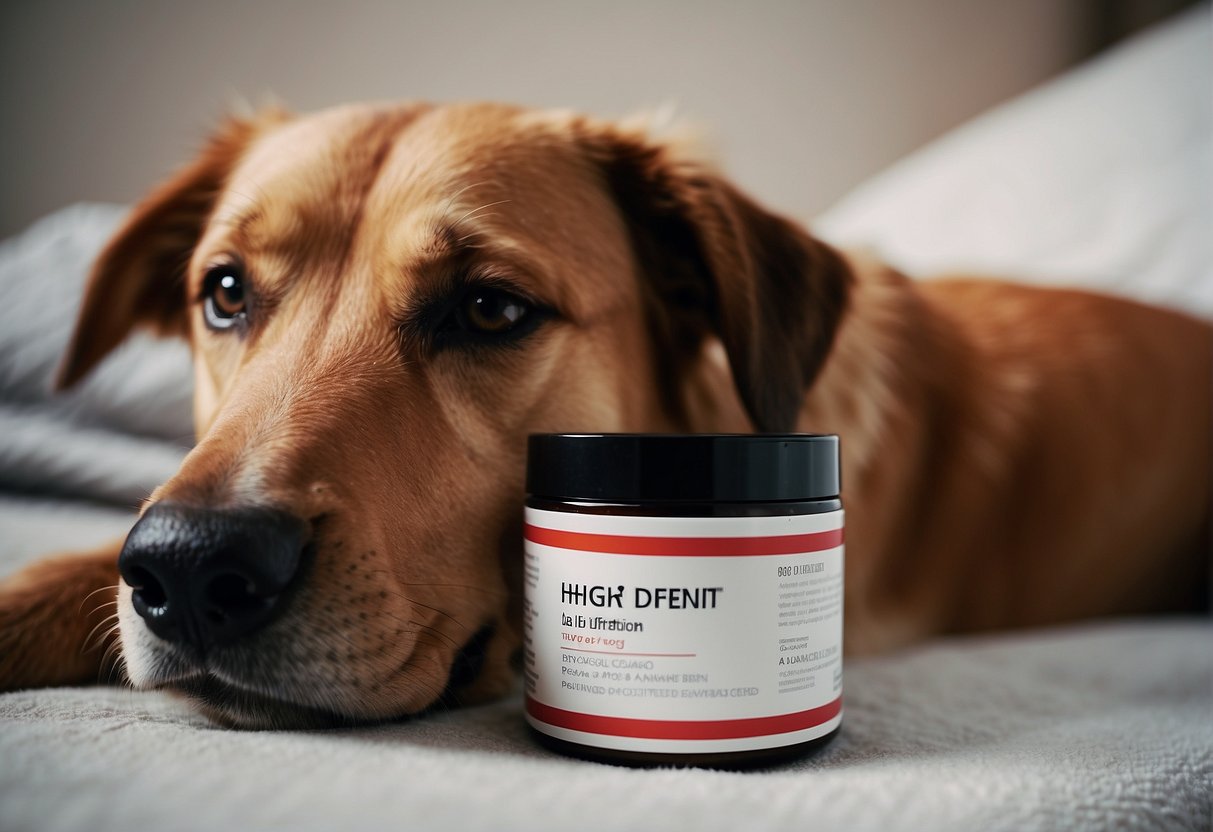When we notice our canine friends scratching or biting at their skin more than usual, it could be a sign of hot spots, also known as acute moist dermatitis.
These are painful, red areas that can appear anywhere on a dog’s body, often exacerbated by moisture, allergies, or stress.
Hot spots can spread rapidly and are both uncomfortable and potentially harmful if not treated promptly.

Treating hot spots at home involves a few steps to alleviate discomfort and prevent further infection.
Keeping the area clean and dry is crucial, as the moist environment promotes bacterial growth.
We need to carefully trim the hair around the hot spot to allow air to reach the skin, which can accelerate healing.
Also, using treatments to soothe the affected area can provide our dogs with much-needed relief.
Understanding the underlying cause of hot spots is also vital to prevent future occurrences.
Whether it’s allergies, behavioral issues, or something in their environment, identifying and managing these triggers is an essential part of our role as responsible pet owners.
While severe cases may require veterinary attention, many hot spots can be managed effectively at home with the right care and attention.
Understanding Hot Spots

When we talk about hot spots on dogs, we’re referring to those red, moist lesions that suddenly appear on our furry friend’s skin.
These are not just unsightly; they can cause significant discomfort due to itchiness and pain.
Essentially, hot spots are areas of bacterial infection, often stemming from an initial irritation.
Let’s break down what hot spots entail:
- Redness and swelling: This is usually the first thing we’ll notice.
A hot spot will appear as a reddened, inflamed area.
- Moisture: These lesions often seem wet or oozing due to the body’s response to the infection.
- Itch and pain: Our dogs will likely react to the discomfort by scratching, licking, or biting the area, which can unfortunately worsen the condition.
Here’s a quick list of symptoms of hot spots in dogs that we may observe:
- Intense itching
- Constant licking or biting at a specific spot
- Red and inflamed skin
- Hair loss around the affected area
- Discharge or a bad smell coming from the lesion
- Scabs or crusts
Inflammation and moisture create the perfect environment for bacteria to thrive, which can lead to a rapid spread if not treated promptly.
So, if we spot these signs, it’s important for us to take action and help our canine companions find relief.
Identifying the Underlying Causes

When we’re faced with hot spots on our dogs, it’s essential to identify what’s causing them to effectively prevent recurrence.
Paying close attention to our dog’s environment, behavior, and health can reveal the triggers that lead to these painful skin lesions.
Allergies and Sensitivities
Our canine friends can develop allergies just like we can.
These allergies might be to food ingredients, environmental allergens like pollen, or even substances around the house.
Dogs with food allergies may experience itchy skin and subsequently cause hot spots by scratching.
Flea allergy is another culprit, where a single flea bite can lead to intense itching and scratching, resulting in hot spots.
It’s important to watch for signs of discomfort that might indicate an allergic response.
Infections and Infestations
Infections, such as ear infections or anal sac disease, can also cause our dogs extreme discomfort and lead to self-inflicted injury, like hot spots.
If we observe our dog scooting or shaking its head frequently, it might be time to inspect for these conditions.
Additionally, external parasites, like mites or ticks, can provoke hot spots.
A bacterial infection, possibly as a result of a broken skin barrier, can exacerbate the situation, often resulting in secondary bacterial infections.
Environmental Factors
Sometimes, the environment itself can be stressful for our dogs.
Stress can lead to compulsive licking, chewing, or scratching that causes hot spots.
These environmental stressors can include abrupt changes in our dog’s routine or living situation.
Humid weather can also contribute to the development of hot spots by creating a favorable environment for bacteria and fungi on the skin.
By being alert to these potential causes, we can create a safer and more comfortable experience for our furry friends.
Recognizing and eliminating these triggers is a vital step in the battle against hot spots.
Immediate Home Care Steps

When your dog develops a hot spot, it’s crucial to act quickly.
Immediate home care can help promote healing, ease discomfort, and prevent further damage caused by your dog scratching or chewing the area.
Let’s walk through the essentials step by step.
Cleaning and Disinfecting
First, we need to make sure the affected area is clean and free from bacteria.
Gently clip any hair surrounding the sore to prevent matting and to allow the spot to dry out.
Use a clean cloth or gauze pad and a vet-approved antiseptic like chlorhexidine to disinfect the sore.
Be gentle to avoid causing more pain. Antiseptic wipes can also be handy for this step.
Reducing Itch and Pain
To soothe your dog’s urge to lick, chew, or scratch the hot spot, we can apply over-the-counter treatments like hydrocortisone cream or spray, which help reduce inflammation and itching.
An Elizabethan collar might be necessary to keep them from reaching the area.
If you notice that they’re still in pain, talk to your vet about safe pain medication or an antihistamine like Benadryl to relieve discomfort.
Preventing Further Injury
Lastly, we need to prevent our four-legged friends from inflicting further injury on themselves.
Aside from the Elizabethan collar, you can apply antibiotic cream or spray, such as Neosporin, to promote healing and protect against infection.
If you find your dog is particularly uncomfortable, a soothing agent containing pramoxine can offer temporary relief without stinging.
Remember, the goal is to keep the area clean, protected, and give it time to heal without interference.
Long-Term Management and Prevention

Hot spots on dogs can be quite distressing, but with proper long-term management and preventive steps, we can significantly reduce the chances of their recurrence.
It’s all about maintaining good skin health, making environmental adjustments, and implementing behavioral interventions to ensure our furry friends stay comfortable and hot spot-free.
Improving Skin Health
To improve skin health, it’s crucial to focus on diet and grooming.
A diet rich in omega-3 fatty acids can promote healthier skin and a shinier coat.
Incorporating fish oils or supplements vet-approved for dogs can make a significant difference.
Consistent grooming, especially for breeds with thick coats like Golden Retrievers, German Shepherds, and Rottweilers, helps prevent matted fur, which can trap moisture and debris leading to hot spots.
Regularly brushing their coat can also help in spotting any early signs of skin conditions.
- Golden Retrievers: Keep their undercoat well-brushed and free of mats.
- German Shepherd Dogs & Rottweilers: Regular grooming to manage heavy shedding and thick undercoats.
Environmental Adjustments
To prevent hot spots, consider the environmental factors that contribute to skin irritation.
Avoid lettings dogs with thick coats or who are prone to hot spots stay wet after swimming or being out in the rain.
Ensure they’re thoroughly dried off to prevent moisture buildup, which can create a breeding ground for bacteria.
We should also provide a clean, dry, and comfortable resting area, reducing the possibility of environmental irritants causing skin issues.
- Swimming: Towel or blow-drying post-swim helps keep the skin dry.
- Rain: Dry off your dog thoroughly after wet outings.
Behavioral Interventions
Lastly, addressing the behavioral aspects means tackling boredom and stress, which can lead to excessive licking or chewing.
Ensuring our dogs have enough mental and physical stimulation is key to preventing such behaviors.
Daily exercises, interactive toys, and training can all help keep a dog engaged and less likely to focus on licking or chewing their fur and skin.
- Boredom: Engage your dog with regular exercise and interactive play.
- Flea Control: Maintain a regular flea control program as prescribed by veterinary care professionals.
By committing to these practices, we’ll not only tackle hot spots head-on but will also ensure the overall well-being of our dogs, keeping them happier and healthier in the long run.
When to Seek Professional Help
While we can manage many mild cases of hot spots at home, there are times when it’s absolutely essential for us to reach out to a veterinarian for professional help.
Let’s look at when we should consider this step:
-
Persistent Infection:
If the hot spot doesn’t improve after our initial home treatments, or if it continues to ooze, smells bad, or is swelling, it’s likely our dog has a deeper skin infection.
-
Large or Spreading Areas:
If the hot spot rapidly expands or covers a large area, it could require a stronger treatment plan that might include oral antibiotics or even steroids.
-
Severe Pain
Our pups will let us know when they’re hurting.
If they react with pain when we approach the hot spot, it’s time for veterinary care.
-
Overall Health of Our Dog:
If our dog seems lethargic, depressed, or has a fever alongside their skin problems, these can be signs of a more systemic issue.
-
Other Medications:
Our pets might already be on other medications that could interact with treatments we’re considering for hot spots.
A vet can provide guidance on what’s safe.
-
Failure of Home Remedies:
When our regular routine of bathing and applying over-the-counter treatments aren’t making a dent, professional help can provide relief.
-
Chronic Issues:
If our dog repeatedly gets hot spots, especially during warm weather, it might be indicative of an underlying condition that needs more than just topical treatment.
We must remember, if at any point we’re unsure or uncomfortable treating our dog’s hot spots on our own, we shouldn’t hesitate to contact our vet.
They’re our allies in ensuring the health and happiness of our furry friends.















